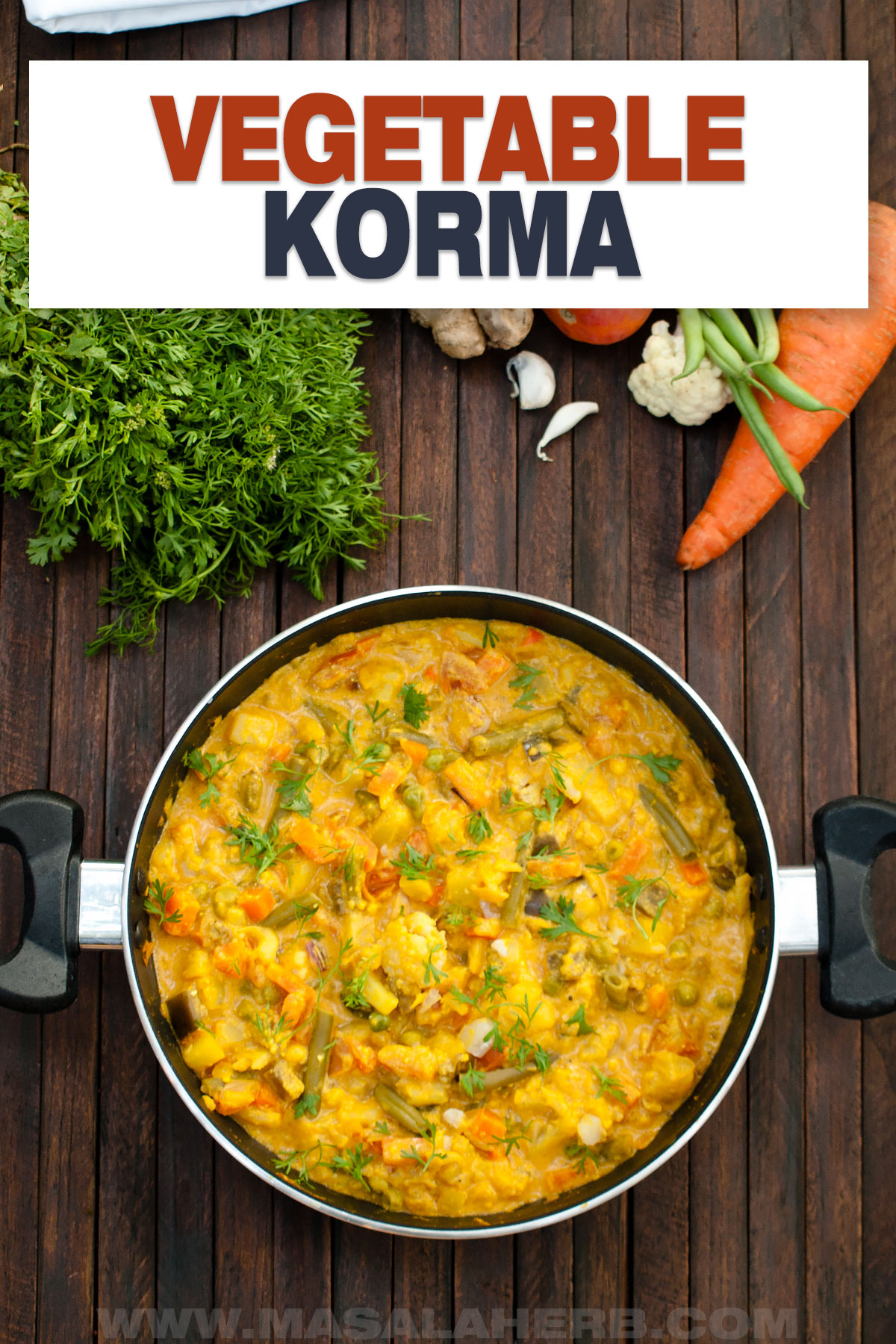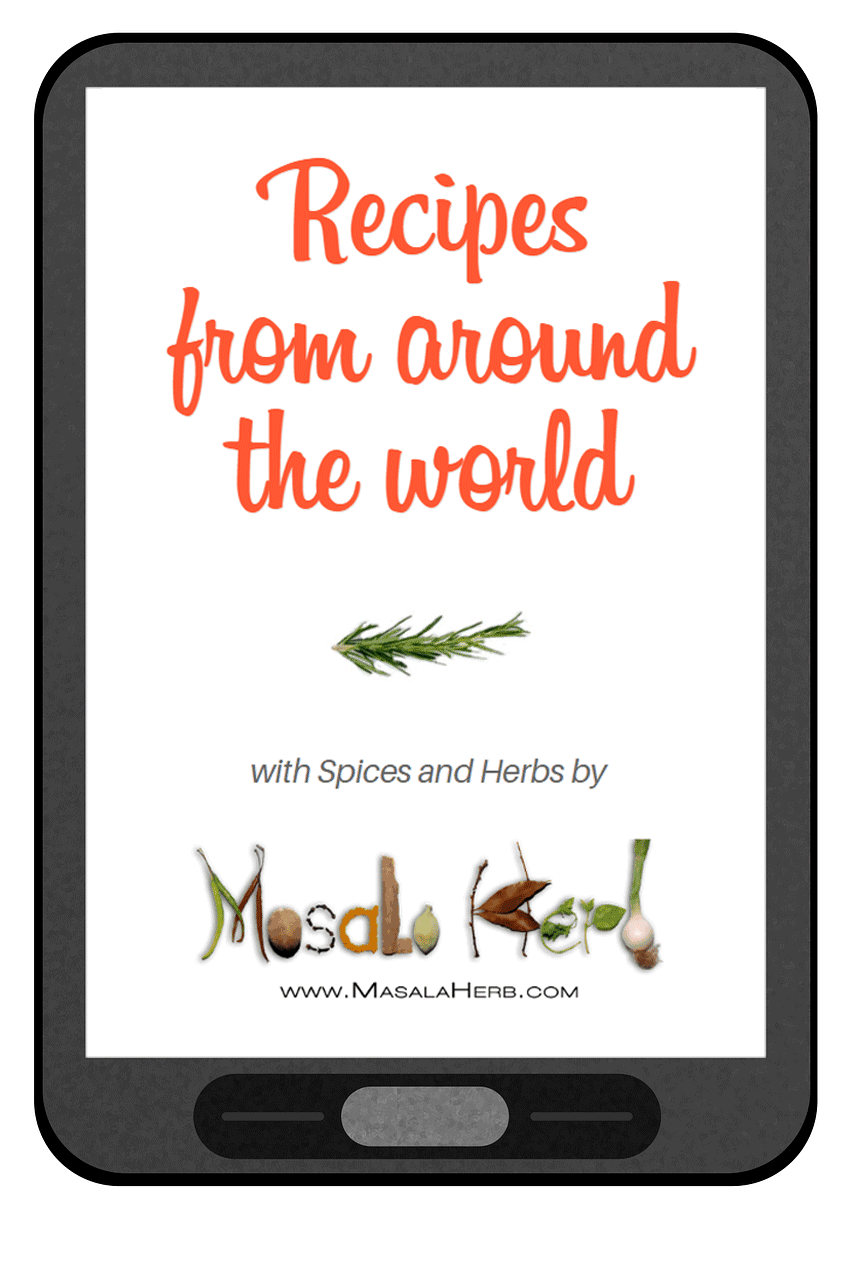
Vegetable Korma is a creamy, lightly spiced curry with green cardamom and yogurt as the main star ingredients.
This simple to prepare nut-free, vegetable mixed Korma (aka Kurma) comes together rather easily since you can use fresh vegetable fridge leftovers or frozen veggies.


Global Food Recipes
with Spices and Herbs
Free E-Book available for a limited time. Grab yours now and get instantly inspired!
You missed out!
Jump to:
What is Korma or Kurma?
Korma is a North Indian dish, in fact, it's a remnant from the Mogul era in India (central Asian descendants).
The meat would be slowly braised in the spiced cream & yogurt-based korma curry.
Typically, in Indian cuisine, Kormas are prepared with meat items such as lamb or chicken korma. British Korma are different and are based on British flavor palates.
Meatless korma has a place too, such as the royal Paneer Korma, aka the Indian cottage cheese Korma Curry (Mughlai Shahi Paneer).
However, the food revolution has taken over the humble creamy korma curry too, and newer variations were created, such as the mixed vegetable korma and shrimp korma.

Ingredients
Most ingredients in this Korma are vegetables and a set of spices. Please don't feel intimidated by the ingredient quantity. It's truly super simple to make this curry!
In the dark gray box are the main ingredients, and in the light gray box are the spices and flavor givers.
- Mixed Vegetables — I generally use whatever I have in my fridge or freezer. That can be fresh or frozen veggies, such as potatoes, cauliflower, carrots, eggplant, green beans and Tomato, to just name a few options. See Notes below.
- Broth — If you want it all vegetarian, use vegetarian broth. You can also use a bouillon cube (i.e. Maggie cube) with water, it's the same result.
- Oil — That can be Coconut Oil, Vegetable Oil, Canola Oil or Sunflower Oil. Try to use cold-pressed oils because these are generally of a higher quality.
- Onion — Red onions are better, but white or yellow onions are ok too.
- Ginger + Garlic — Ginger and garlic in paste form OR finely chopped garlic and grated ginger.
- Tomato diced
- Tomato Sauce — unflavored
- Cream - You can use table cream, heavy cream or if you can get crème fraîche (French Cream), use that.
- Greek Yogurt
- Bay Leave — In India they will use Indian bay leaf, but you can make this with standard western bay leafs too. Both versions are acceptable.
- Green Cardamom Pods — whole, slightly stamped to release the flavor. High-quality cardamom is always super green, lower quality looks faded, and it's either lower quality or old.
- Turmeric Ground
- Cumin Seeds Ground
- Coriander Seeds Ground
- Red Chili Pepper Ground — Use your regular ground chili powder or pick the one that is hot called tikhalal or get the Kashmiri ground chili pepper because that's not hot and adds a pleasant red color.
- Black Pepper Ground
- Salt to taste
- Cilantro Fresh — to garnish, aka fresh Coriander leaves in India.


Notes: For the Veggies, pick what you have in your fridge or try to pick a balanced vegetable selection. This can be 1 carrot, 1 eggplant, 1 bigger potato and the rest green peas, cauliflower, broccoli, green beans, or even Asian vegetables as in yard long beans, ridge gourd, red amaranth leaves or whatever neutral vegetable that you have. Don't use okra (gets slimy), bitter gourd (gets too bitter) and similar.
How to make it?
Step 1
Prep vegetables, cut onion and tomato.
Pre-boil vegetables.

Step 2
Cook onions and temper spices in oil.


Step 3
Continue to add tomatoes and tomato sauce with black pepper.

Step 4
Stir in veggies and broth.

Step 5
Then add the cream and yogurt.
Taste to season with salt and cook for a few minutes until it's done in texture and flavor.


Step 6
Pick out whole spices and discard, when done cooking.
Garnish with cilantro and serve up hot.

📖 Recipe

Creamy Mixed Vegetable Korma with Yogurt Recipe
Ingredients
- 3.5 cups Mixed Vegetables *See Notes
- 2 Tablespoon Oil *See Notes
- 1 Onion chopped or finely sliced
- 1 Tablespoon Ginger + Garlic *See Notes
- 1 Bay Leaf small or a piece
- 4 Green Cardamom Pods whole, slightly stamped to release aroma
- 1 Teaspoon Turmeric Ground
- ½ Teaspoon Cumin Seeds Ground ground
- ½ Teaspoon Coriander Seeds Ground ground
- ½ Teaspoon Red Chili Pepper Ground
- 1 Tomato diced
- 3 Tablespoon Tomato Sauce
- Pinch Black Pepper Ground
- 1½ Cup Broth
- 5 Tablespoon Table Cream *See Notes
- 2 Tablespoon Greek Yogurt
- Salt to taste
- Cilantro Fresh to garnish, aka fresh Coriander leaves
Instructions
If you use fresh raw vegetables
- Chop or slice the onion small. Wash, peel and cut your vegetable into bite-sized pieces. Keep the eggplant and tomato apart (and any vegetables such as spinach) because the cooking period is shorter.3.5 cups Mixed Vegetables
To cook the Korma
- In the meanwhile, add the oil to a pan and fry your cut onion soft and translucent over a medium high heat setting.2 Tablespoon Oil, 1 Onion
- Briefly take from the heat and add your ginger garlic paste, bay leaf, and slightly crushed cardamom seeds. Quickly stir cook, and temper for 1 minute or so over a medium heat setting. (be careful, ginger garlic paste is semi liquid and jumps up in the hot oil.1 Tablespoon Ginger + Garlic, 1 Bay Leaf, 4 Green Cardamom Pods
- Take again from the heat and continue to add in the other spices: ground turmeric powder, ground cumin powder, ground coriander powder and red ground chili powder. Stir-fry for 1 minute over a medium heat setting.1 Teaspoon Turmeric Ground, ½ Teaspoon Cumin Seeds Ground, ½ Teaspoon Coriander Seeds Ground, ½ Teaspoon Red Chili Pepper Ground
- Add in the tomato and stir-cook for a minute over a medium-high heat setting.1 Tomato
- Reduce the heat and continue stirring in the tomato sauce and black pepper. Stir-cook to incorporate the ingredients on a medium heat setting.3 Tablespoon Tomato Sauce, Pinch Black Pepper Ground
- Add all the vegetables and the broth.1½ Cup Broth
- Mix the entire contents thoroughly and allow to simmer for a minute or two on a medium flame.
- Stir in the cream and incorporate it into the veg korma curry. Leave to cook for a couple of minutes so that the flavors get into the curry.5 Tablespoon Table Cream
- Reduce the heat to a minimum and toss in the yogurt. Mix it all well.2 Tablespoon Greek Yogurt
- Season with salt and simmer on a lower heat for 5 minutes, or until you are satisfied with the consistency and flavor.Salt
- Pick out and discard your whole spices, the bay leaf and cardamom pods, before you garnish and serve your korma.
- Garnish with chopped fresh cilantro (aka fresh coriander) and serve hot with Indian flatbread such as bread, Indian roti, paratha, naan or cooked rice.Cilantro Fresh
Notes
- You can use whatever vegetables you have in your fridge. You can use veggies such as Carrot, Cauliflower, Green Peas, Eggplant, Green Beans, Spinach, Potatoes. I use vegetables that are about to go bad because I care about saving vegetables and zero waste.
- Use a neutral flavored oil, as in vegetable oil, canola oil, sunflower oil. If you want to go all Indian, get coconut oil and if you are daring and seeking new flavors, try mustard seed oil.
- You can use the water that was utilized to boil your vegetables as a broth in the curry. Use that broth for the curry after cooking the vegetables.
- Use fresh ginger and Garlic finely chopped or grated (ratio 1:2) or use ginger and garlic paste. I, personally, prefer the paste because it mixes in faster, and it's more convenient, but if you want more flavors, use fresh ingredients only.
- For the Cream, you can use either table cream (like the canned Nestlé ones), heavy cream or french Crème fraîche. Personally, I'm all about the fresh cream.
Nutrition
Korma Cooking Tips
Korma needs to be cooked on a slower heat setting or the yogurt will curdle in the curry.
You can stabilize the yogurt so that the veg kurma doesn't curdle, by following my tips:
- Add cream when preparing the korma, first before adding the yogurt. Cream helps in stabilizing the yogurt.
- Use creamy, heavier, high in fat yogurt (like Greek yogurt). If you use Indian Curd, strain the curd from the water overnight through a cheese cloth.
- Don't bring the curry with the yogurt to boil. If you boil it, you will see patches of curdled yogurt and the creaminess will be gone. Therefore, I add the yogurt at the end to the dish, I let it cook on a lower-heat setting while mixing the content slowly and then at the end I season it with salt.
- The combination of Ginger and Garlic helps in stabilizing milk products, such as yogurt, in this vegetable korma.
Furthermore, I use the ginger paste mixed with garlic paste in this vegetable kurma recipe.


Serving
Vegetable korma is best enjoyed over cooked basmati rice. If you are looking for flavor options, serve it up with lemon flavored rice or cilantro lime infused rice.
You can also serve the curry with flat breads such as wholewheat roti, naan, or pita bread. I like it with regular buns too.
Storing
Leftovers of your vegetable korma are good for at least 6 days, refrigerated.
I typically prepare a batch on Sundays to meal prep for the week, and then I also freeze them.
The best containers for freezing, refrigerating and then reheating again are rectangular glass storage containers.


